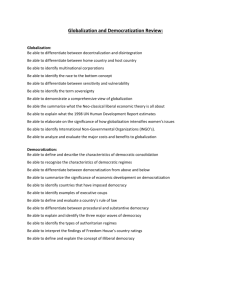Visual Arts - Essex Garner
advertisement
8750 Research in Art Education Essex Garner Research Question What are the effects of Democratization of the Visual Arts in Relationship to Technology How has the Democratization of the Visual Arts effected its Relationship to Technology? What is Democratization of the Visual Arts? It is a concept that every individual can engage in the arts, and all of those individuals are free to express the creativity within the media, and the arts is not simply for those who are trained or otherwise skilled, but anyone. Typically, art and art history was something only the privileged could either afford or study, although in today’s society the field is gradually becoming more available to the everyday person, making it a more democratic phenomena. Baby Boomers also helped with the democratization of the visual arts: They (we) grew up believing anyone could become an artist, and anyone could buy art or deal in art. PhotoShop is another factor of the democratization process, and the cheapening of visual media. Research Proposal: The investigation of why are the visual arts becoming a more democratized phenomenon in relationship to technology? How was the visual art instructional method at the root of civilizations pedagogical development, and why is it imperative that the visual arts take us into the next millennium and beyond? How has the Democratization of the Visual Arts effected our educational system? Answer: DBAE What is DBAE Discipline-Based Art Education (DBAE) is a method of teaching and studying art in the modern classroom that exposes students to four distinct art disciplines: criticism, aesthetics, art history and art production. Developing knowledge and skills in these four areas allows students to attain a more thorough comprehension of visual arts. Supporting data of the democratization correlation of integrating DBAE in the classroom with traditional curriculum development and technology: • 65 % of the population are visual learners. • The brain processes visual information 60,000 faster than text. • 90 % of information that comes to the brain is visual. • Visual aids in the classroom improve learning by up to 400 percent. • Students who are twice exceptional (2e) are often visual learners. Assumptions: There is a “Love/Hate relationship” of Visual Artist’s in reference to this democratization. • A great number of graphic artists and illustrators where put out of work because of it. • However, the same graphic artists and illustrators today are needed to design and conceive visual interfaces with almost everything we come in contact with in this global society. • There has been a marginalization of the study of the visual arts, and its importance in relationship to our societal developments. • There is also a marginalization of the visual artist themselves which impacts the validity of the pedagogical standing. • “Stereotyping” = Those visual artists are not like the rest of us. • The same psychomotor dexterity that’s needed to produce in the Fine Arts domain is needed to produce in the Digital Arts domain. Limitations of this democratization: (Pro and Cans) • Availability of visual resources in or out of the classroom for teachers, students, and the everyday user of the media. • The aesthetics and visual effects in digital media are becoming relative to the amount of money one can spend on their equipment. (Matter Matters versus the Digital Divide). • Not all classrooms or school districts can afford keeping abreast of visual technology. Although technology is becoming less expensive, which ultimately makes it more democratic; what’s cheap for one person or school may still be too high a cost for another. Limitations “Cons” of democratization (Con’t) Why? • Studio classes in the visual arts are expensive. • Expensive textbook (pictures cost more to print). • Apps, software, computers and media equipment is forever being upgraded, and keeping abreast of these upgrades becomes an economic impossibility for many. The democratization of the Visual Arts is about “control” or the loss of it. You may have heard this one before: • With all this new visual technology at my fingertips, and I, being a person with innate spatial intelligence; why do we need visual arts instructors. Answer: Would you build your home on a faulty foundation. The language of visual literacy is the cornerstone of our anthropological lineage. Someone has to be able to connect the language of visual literacy with the mathematician, scientist, and explorers to “design” vehicles that will ultimately take us out of this solar system and beyond. Methods of Research and Analysis: • Starting with the quantitative approach, and then refining the data using quantitative method. • Individual surveys of my students and willing participants. • Review and compare research findings in educational, and media data. Research Questions and sub question: How is technology changing art? RQ1 - Are you more inspired when using technology to think about art in new ways? RQ2 - Would you prefer a computer to draw or a pen and paper? RQ3 - Does digital media scare you or are you technically savvy? RQ4 - Which is more important: Ones ability to draw or ones ability to understand the process? RQ5 - Which would you prefer in this class as the major part of your grading rubric; test scores or your portfolios analysis? RQ6 - Has technology helped with your understanding of the Fine Arts in this class? RQ7 - Would you prefer this class to be all on-line or taught in the traditional method? RQ8 - Would you prefer to visit a museum on-line or in person. RQ9 - Has technology made you a better visual artist? Sub question: Has digital media improved your comprehension of Visual Literacy. Possible Findings: • Our first educators were the Paleolithic visual artists. • The democratization of the visual arts is inevitable, and it is not a new phenomenon, because the first learning tools for our civilization were in fact visual” Example: Rosette Stone and Hieroglyphics. • Globalization, “control”, and automation are the driving forces behind this democratization. • “In my opinion” the word “artist” is used too loosely. Other notes that are in support of the democratization phenomenon: • The Getty Museum lets users view art online in 3D with the help of augmented reality technology. • You can now take virtual tours through Michelangelo’s Sistine Chapel. • You can look at renaissance paintings in the Uffizi Gallery in Florence “all for free.” Timeline: - Interview students at the beginning of the semester - Continue the discussion and related topics through midterm. - Interview and survey students at the end of the semester to see what opinions of democratization may have been altered. - During the last week of class report the quantitative numbers to the class and other related data findings. Permission: Yes, from the students themselves. Literary Information: Gangwer, Timothy (2009). Visual Impact, Visual Teaching, Using Images to Strengthen Learning. Introduction to Visual Teaching. Corwin Press. Gude, Oliva (2009). 2009 Lowenfeld Lecture by Olivia Gude, Art Education for a Democratic Life. Retrieved June 10, 2012, From: http://www.arteducators.org/research/2009_LowenfeldLecture_OliviaGude.pdf Elsevier , (2005). Democratization of the arts, Jonas: Mosby's Dictionary of Complementary and Alternative Medicine. Retrieved June 14, 2012, From: http://medical-dictionary.thefreedictionary.com/democratization+of+the+arts National Art Education Association, NAEA (2011). Position Statement on 21st CenturySkills and Visual arts Education. Reston, VA. Retrieved June 10, 2012, From: http://www.arteducators.org/Alphabetical_Listing_of_Position_Statements_Adopted_as_of_July_2011.pdf National Assembly of State Art Agencies (2006). Critical Evidence, How the ARTS Benefit Student Achievement. Retrieved June 10, 2012, From: http://www.nasaa-arts.org/Research/Key-Topics/Arts-Education/critical-evidence.pdf Pink, D. (2005). A Whole New Mind: Why Right-Brainers Will Rule the Future. The Penguin Group New York, NY Visual Teaching Alliance (2012), Pre-K-Adult. Facts, The Visual Teaching Alliance Statistics: Teacher Training Workshops Tools and Resources. Round Rock, TX. Retrieved June 15, 2012. From: http://www.visualteachingalliance.com/ Possible Findings. • Computers may not be as critical to learning as modern educators give them credit for, but the human brain is. The democratization of the visual arts is the inevitable part of this process. • The next generation of visual artist will have more global opportunities and employment than we think. Teaching our children about the visual arts and DBAE is a solid part of this foundations future. • Right brainers will rule the world (Pink, 2005), and the visual artist will be their supervisor. The future is here
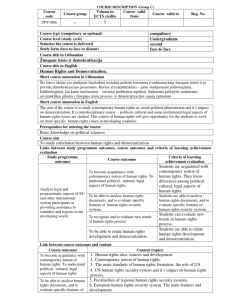
![how-question strong incentives and means to block [the process] relational-mechanisms:](http://s2.studylib.net/store/data/011168808_1-1a3c3acbd5e45945bbd2cdde19d0f42f-300x300.png)

